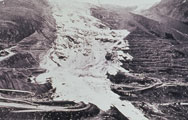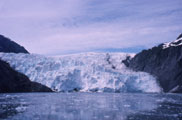 |
|
|
|
|
|
|
Many mountain regions reach altitudes with severe climatic conditions where low temperatures reflect essential limits to living conditions. Such areas also constitute the most characteristic and attractive landscapes dominated by snow and ice. The two perennial ice components, glaciers and permafrost, react sensitively to changes in atmospheric temperature because of their proximity to the melting point. In addition, mass wasting is most intense in high mountain areas with steep slopes. As a consequence, climatic changes cause pronounced effects in the glacial and periglacial belts of mountain areas. The 20th century has, indeed, seen striking changes in glacierised areas of mountain ranges and, hence, in the extent of glacial and periglacial mountain belts all over the world. This development has been accompanied by increased human activity in cold, high mountain ranges. It is, in fact, the combination of vanishing ice and human impact, which has introduced the most striking changes in high mountain landscapes. Such changes in the directly visible (glaciers) and more invisible (permafrost) components of the alpine cryosphere are of highest significance, not only as signals of ongoing change (see IPCC 2001), but also with respect to their impact on a much larger scale. These changes are now monitored as part of global, climate-related observing systems (GCOS/GTOS; Cihlar and others 1997, Haeberli and others 1997, Harris and others 2001). Perennially frozen slopes occur in many mountain ranges of the world (Cheng and Dramis 1992). Ice-rich debris or morainic material primarily exist under subcontinental to continental-type climatic conditions with elevated glacier equilibrium lines. Such supersaturated mountain permafrost exhibits pronounced creep movements, thereby forming large numbers of rock glaciers. |
|
Reactions of mountain permafrost to climatic changes take place in the form of: |
|||
|
|||
|
Active layer thickness and borehole temperature are considered key variables in long-term monitoring programmes. |
|||
|
Systematic research on permafrost in high/cold mountain areas is quite recent in contrast to glacier research. Even today the fact that ground materials (debris, bedrock) may remain below 0°C for extended time periods and contain large amounts of ice remains unknown to many. Severe atmospheric warming and its influence on ground thermal conditions, on the other hand, lead to concern for a variety of engineering and environmental aspects (Haeberli 1992). This concern, in turn, has led to intensified research into such phenomena as creep of frozen ice-rich debris (rock glaciers, cf. Kääb and others, 1997, 1998), frost weathering in permafrost (Matsuoka 1998) or slope stability (Davies and others, 2001; Haeberli and others 1997, Wegmann and Keusen 1998, Noetzli and others 2003). Periglacial mountain belts would be among the most heavily affected parts of the world in the event of accelerated future warming. Because the energy balance at permafrost surfaces is dependant on various complicatedly related factors, potential future changes can only very roughly be estimated. Lower limits of permafrost occurrence in mountain areas could rise by several hundred meters. Such a tendency, however, could be counterbalanced to some degree by a reduction of thermally insulating winter snow. On the other hand, shorter snow cover duration during the spring and early summer months when energy influx from the atmosphere is highest could also enhance warming effects. Due to the slow reaction of thermal conditions at greater depth, pronounced disequilibria are most likely to result over extended time periods and wide areas. |
|
Some effects that are sometimes related to permafrost and glacier changes are illustrated by the photos below: |
|
Permafrost |
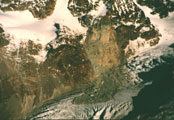 1 - Rock fall on October 29, 1988 from the south-west wall of Piz Morteratsch (120K) |
 2 - Rock fall on July 28, 1987 in the east wall of Monte Zandila (92K) |
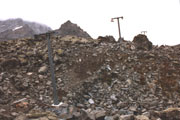 3 - Skilift built over a rock glacier front. Problems occurred regularly with the stablitiy of the skilift mast. The skilift was finally replaced by a chair lift. (116K) |

4 - Starting zone of a large 1987 debris flow near Saas glacier (132K) |
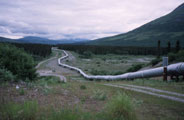
5 - A part of the Trans-Alaska Pipeline System 1 | 2 | 3 | 4 (80K,80K,56K,92K) |
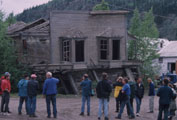 6 - House in Dawson City, severely affected by the existence of subsurface permafrost (100K) |
|
Glaciers |
29 August 2011 |
||
| |
||

